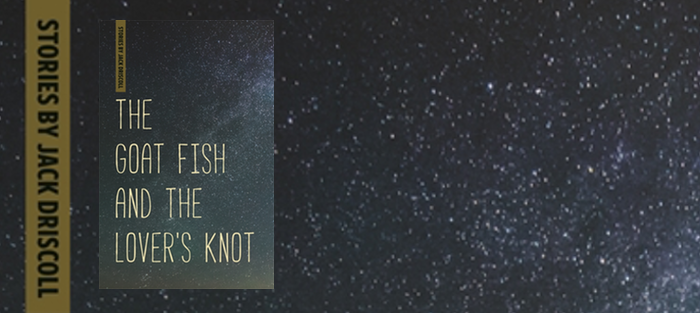A striking feature of Jack Driscoll’s wonderful new collection, The Goat Fish and the Lover’s Knot, published in April by Wayne State University Press, is its fascination and awareness of time. In particular, how events in our lives link up in interesting, unexpected ways: a man in his forties, while at the lake with his daughters, recalls a charged moment from his early teens; a young narrator breezily sets up a story with phrases such as “it’s been a few months since he liquefied the pure-grade silver…” and a mention of his mother’s “wicked purple skin graft…ever since the attack,” giving us a sense of plenty happening off the page, of having arrived smack in the middle of a story with high, dramatic stakes and a lifetime of loss behind him.
Driscoll also knows how to use time to impart urgency in these stories. Time only moves in one direction, lamentably so, a fact of which Driscoll’s characters are keenly aware, whether they like it or not. And yet. Time is not exactly linear. The theme resonates through the book, and in the story “On This Day You Are All Your Ages,” it sings. “If you could, you’d bury the past and live each day as if it were your last.” Indeed.
Carelessness—and loneliness—also figure prominently in these stories, as well as the sense that one silly act might change a life. We only really live with ourselves, and this statement is pushed up against a certain desperation, sometimes economic, sometimes emotional, giving these stories a shimmering, frequently melancholic, heat. For it’s in the midst of these singular actions—or moments of inaction—that we truly witness the weight of time and its temporal gravity. Perhaps more important, because of who these characters are—often middle class or poor, often rural, often without opportunities, and rarely with much on which to fall back—these singular actions often stand out more keenly in the story of a character’s life, coming to encompass or define them.
In a recent New York Times Book Review column, “Bookends,” wherein two writers discuss issues related to contemporary fiction, Siddhartha Deb thoughtfully laments that contemporary fiction fails to address issues of class and economic hardship. I’m not sure if I wholeheartedly agree with this assessment, but I’ll grant that we’ve had our fair share of solipsistic, overprivileged narrators. The antidote, then, is the work of Jack Driscoll. These stories, regardless of their setting in time and space, are of a contemporary moment often overlooked: people struggling to make ends meet, to stay alive. And when a character glibly asks, “What’s to lose?” the stories that have come before already suggest something the author knows that the narrator might not. Plenty.
But these stories are not just desperation. There’s a beauty here, both in language and in content, and Driscoll is the master of capturing a delicate humanity where most people might be least likely to look. It is no accident that this collection ends with a story about miracles, and the arc of this book as a collection is beautiful and deliberate. Narrative’s tension comes from time, after all, and what is time but a life unfolding?







